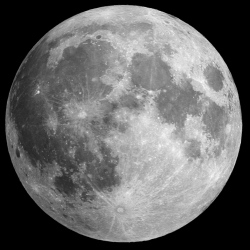
The Moon used to spin on a different axis and show a slightly different face to the Earth, a new study suggests. Using data collected by Nasa’s Lunar Prospector mission in the late 1990s, scientists spotted two hydrogen-rich regions near the Moon’s poles, probably indicating the presence of water ice.
The icy patches are opposite each other – the line between them passes through the middle of the Moon, so it appears that this used to be its spin axis. The work appears in the journal Nature. It describes a gradual wobble, or "true polar wander", adding up to about a six-degree shift altogether.
A likely explanation for this shift, which the researchers suggest took place over several billion years, is volcanic activity in a region called the Procellarum. This swathe of territory includes most of the Moon’s dark patches that are visible from the Earth. Volcanoes and associated geological activity would have made it warmer and lighter than the rest of the Moon.
According to Matt Siegler, from the Planetary Science Institute in Arizona, and his colleagues, that drop in density produced enough wobble to explain the two "palaeopoles" they detected in the Lunar Prospector data.
"The Procellarum region was most geologically active early in lunar history, which implies that polar wander initiated billions of years ago," they write.
